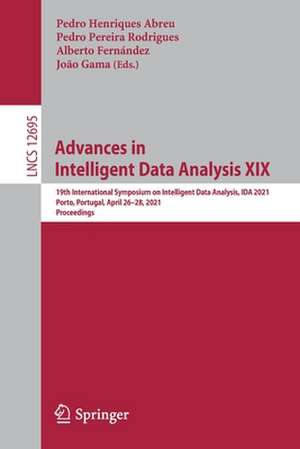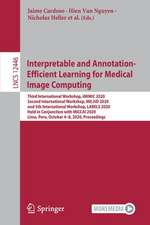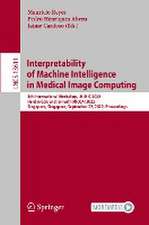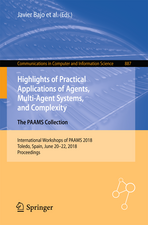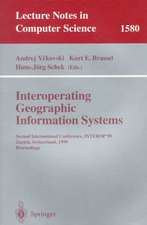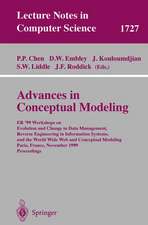Advances in Intelligent Data Analysis XIX: 19th International Symposium on Intelligent Data Analysis, IDA 2021, Porto, Portugal, April 26–28, 2021, Proceedings: Lecture Notes in Computer Science, cartea 12695
Editat de Pedro Henriques Abreu, Pedro Pereira Rodrigues, Alberto Fernández, João Gamaen Limba Engleză Paperback – 13 apr 2021
Din seria Lecture Notes in Computer Science
- 20%
 Preț: 1061.55 lei
Preț: 1061.55 lei - 20%
 Preț: 307.71 lei
Preț: 307.71 lei - 20%
 Preț: 438.69 lei
Preț: 438.69 lei - 20%
 Preț: 579.30 lei
Preț: 579.30 lei -
 Preț: 410.88 lei
Preț: 410.88 lei - 17%
 Preț: 427.22 lei
Preț: 427.22 lei - 20%
 Preț: 596.46 lei
Preț: 596.46 lei - 15%
 Preț: 448.04 lei
Preț: 448.04 lei - 20%
 Preț: 353.50 lei
Preț: 353.50 lei -
 Preț: 389.49 lei
Preț: 389.49 lei - 20%
 Preț: 309.90 lei
Preț: 309.90 lei - 20%
 Preț: 645.28 lei
Preț: 645.28 lei - 20%
 Preț: 763.23 lei
Preț: 763.23 lei - 15%
 Preț: 580.46 lei
Preț: 580.46 lei - 20%
 Preț: 310.28 lei
Preț: 310.28 lei - 20%
 Preț: 655.02 lei
Preț: 655.02 lei - 20%
 Preț: 1183.14 lei
Preț: 1183.14 lei - 20%
 Preț: 340.32 lei
Preț: 340.32 lei -
 Preț: 449.57 lei
Preț: 449.57 lei - 20%
 Preț: 591.51 lei
Preț: 591.51 lei - 18%
 Preț: 938.83 lei
Preț: 938.83 lei - 20%
 Preț: 337.00 lei
Preț: 337.00 lei - 20%
 Preț: 649.50 lei
Preț: 649.50 lei - 20%
 Preț: 607.40 lei
Preț: 607.40 lei - 20%
 Preț: 1414.79 lei
Preț: 1414.79 lei - 20%
 Preț: 1024.44 lei
Preț: 1024.44 lei - 20%
 Preț: 583.40 lei
Preț: 583.40 lei - 20%
 Preț: 453.32 lei
Preț: 453.32 lei - 20%
 Preț: 575.49 lei
Preț: 575.49 lei - 20%
 Preț: 1075.26 lei
Preț: 1075.26 lei - 20%
 Preț: 585.88 lei
Preț: 585.88 lei - 20%
 Preț: 825.93 lei
Preț: 825.93 lei - 17%
 Preț: 360.20 lei
Preț: 360.20 lei - 20%
 Preț: 763.23 lei
Preț: 763.23 lei - 20%
 Preț: 340.32 lei
Preț: 340.32 lei - 20%
 Preț: 504.58 lei
Preț: 504.58 lei - 20%
 Preț: 369.13 lei
Preț: 369.13 lei - 20%
 Preț: 580.93 lei
Preț: 580.93 lei - 20%
 Preț: 343.62 lei
Preț: 343.62 lei - 20%
 Preț: 350.21 lei
Preț: 350.21 lei - 20%
 Preț: 583.40 lei
Preț: 583.40 lei - 20%
 Preț: 583.40 lei
Preț: 583.40 lei - 15%
 Preț: 438.59 lei
Preț: 438.59 lei - 20%
 Preț: 341.95 lei
Preț: 341.95 lei - 20%
 Preț: 238.01 lei
Preț: 238.01 lei - 20%
 Preț: 538.30 lei
Preț: 538.30 lei
Preț: 340.98 lei
Preț vechi: 426.22 lei
-20% Nou
Puncte Express: 511
Preț estimativ în valută:
65.25€ • 70.86$ • 54.81£
65.25€ • 70.86$ • 54.81£
Carte tipărită la comandă
Livrare economică 23 aprilie-07 mai
Preluare comenzi: 021 569.72.76
Specificații
ISBN-13: 9783030742508
ISBN-10: 3030742504
Pagini: 600
Ilustrații: XVI, 454 p. 138 illus., 107 illus. in color.
Dimensiuni: 155 x 235 mm
Greutate: 0.65 kg
Ediția:1st ed. 2021
Editura: Springer International Publishing
Colecția Springer
Seriile Lecture Notes in Computer Science, Information Systems and Applications, incl. Internet/Web, and HCI
Locul publicării:Cham, Switzerland
ISBN-10: 3030742504
Pagini: 600
Ilustrații: XVI, 454 p. 138 illus., 107 illus. in color.
Dimensiuni: 155 x 235 mm
Greutate: 0.65 kg
Ediția:1st ed. 2021
Editura: Springer International Publishing
Colecția Springer
Seriile Lecture Notes in Computer Science, Information Systems and Applications, incl. Internet/Web, and HCI
Locul publicării:Cham, Switzerland
Cuprins
Modeling with Neural Networks.- Hyperspherical Weight Uncertainty in Neural Networks.- Partially Monotonic Learning for Neural Networks.- Multiple-Manifold Generation with an Ensemble GAN and Learned Noise Prior.- Simple, Efficient and Convenient Decentralized Multi-Task Learning for Neural Networks.- Deep Hybrid Neural Networks with Improved Weighted Word Embeddings for Sentiment Analysis.- Explaining Neural Networks by Decoding Layer Activations.- Analogical Embedding for Analogy-based Learning to Rank.- HORUS-NER: A Multimodal Named Entity Recognition Framework for Noisy Data.- Modeling with Statistical Learning.- Incremental Search Space Construction for Machine Learning Pipeline Synthesis.- Adversarial Vulnerability of Active Transfer Learning.- Revisiting Non-Specific Syndromic Surveillance.- Gradient Ascent for Best Response Regression.- Intelligent Structural Damage Detection: a Federated Learning Approach.- Composite surrogate for likelihood-freeBayesian optimisation in high-dimensional settings of activity-based transportation models.- Active Selection of Classification Features.- Feature Selection for Hierarchical Multi-Label Classification.- Bandit Algorithm for Both Unknown Best Position and Best Item Display on Web Pages.- Performance prediction for hardware-software configurations: A case study for video games.- avatar | Automated Feature Wrangling for Machine Learning.- Modeling Language and Graphs.- Semantically Enriching Embeddings of Highly In ectable Verbs for Improving Intent Detection in a Romanian Home Assistant Scenario.- BoneBert: A BERT-based Automated Information Extraction System of Radiology Reports for Bone Fracture Detection and Diagnosis.- Linking the Dynamics of User Stance to the Structure of Online Discussions.- Unsupervised Methods for the Study of Transformer Embeddings.- A Framework for Authorial Clustering of Shorter Texts in Latent Semantic Spaces.- DeepGG: a Deep Graph Generator.- SINr: fast computing of Sparse Interpretable Node Representations is not a sin.- Detection of contextual anomalies in attributed graphs.- Ising-Based Louvain Method: Clustering Large Graphs with Specialized Hardware.- Modeling Special Data Formats.- Reducing Negative Impact of Noise in Boolean Matrix Factorization with Association Rules.- Z-Hist: A Temporal Abstraction of Multivariate Histogram Snapshots.- muppets: Multipurpose Table Segmentation.- SpLyCI: Integrating Spreadsheets by Recognising and Solving Layout Constraints.- RTL: A Robust Time Series Labeling Algorithm.- The Compromise of Data Privacy in Predictive Performance.- Efficient Privacy Preserving Distributed K-Means for Non-IID Data.
